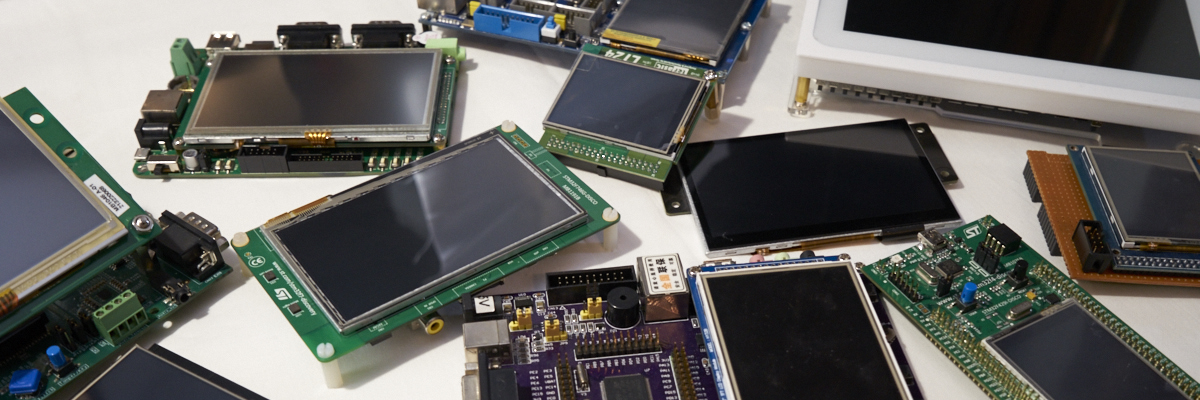-
Posts
2,659 -
Joined
-
Last visited
-
Days Won
2
Content Type
Forums
Store
Downloads
Blogs
Everything posted by Joel Bodenmann
-
That's interesting. Could you please leave some detailed information of the compiler you're using and also your build flags? What does that mean? Can you please give some more details?
-
Have a look at the /demos directory. Especially /demos/tools in your case.
-

Running µGFX on ESP32 and Arduino IDE
Joel Bodenmann replied to Paul Christopher's topic in User Projects
Nice, much appreciated! -
Welcome to the µGFX community! Happy to hear that you managed to get things up and running
-
Hello and welcome to the µGFX community! Unfortunately, there isn't an existing GINPUT driver for that touch screen controller. However, it's very easy to add a new one. Take the existing drivers as an example. You can simply copy the one who matches your controller the best (eg. don't take the ones which use the microcontroller's ADC to determine the touch coordinates) and modify from there. The entire driver interface is well documented in the corresponding GINPUT documentation. Please don't hesitate to ask if you have any questions - we're happy to help wherever we can!
-

HTML2COLOR compile error on STM32F769 Discovery Board in SW4STM32
Joel Bodenmann replied to Andrew W's topic in Support
Thank you for bringing this to our attention. I've modified the documentation accordingly. -
Thank you for sharing your progress & files with everybody - much appreciated! µGFX can definitely do a lot better than that. µGFX does provide those kind of features as well (in a much bigger scope even). We basically call those "hardware acceleration". There are a number of functions that a GDISP driver can implement to use hardware acceleration. For rectangles that would be the `fill area` function. You can have a look at existing drivers. As you'll see it's simply a matter of turning the hardware support for a feature on in the drivers configuration file and then implementing the corresponding function. Have a look at the ST7735 driver for an example. You can see that GDISP_HARDWARE_FILLS is enabled in the drivers config file (gdisp_lld_conf.h) and that the drivers implementation file (gdisp_lld_ST7735.c) is implementing the corresponding hardware filling function named gdisp_lld_fill_area(). The actual implementation of such a function varies a lot. Some display controller have a simple command which takes X, Y, width, height and color while other drivers rely on using DMA and similar techniques to speed things up.
-
@David Thomas is correct. You're missing some board support package files. You will find that µGFX also supplies those as part of the board files for the STM32F746 Discovery board files. You can find them under /boards/base/STM32F746-Discovery. Just add the appropriate files that you're missing (most notably the SDRAM ones) and you should be ready to go After all, board files are completely application specific. You're not forced to use what you find in the /boards directory. If you're using another framework you can either use their board files (if they exist already) or create your own. Board files are just there to give the µGFX driver(s) access to the actual hardware. You'll find a board file template in each driver directory (eg. /drivers/gdisp/STM32LTDC in your case) which you can implement however you want using whatever you want.
-
Hello @cchilumbu and welcome to the µGFX community! This topic is very old and there has been a lot of improvements in all corners of µGFX. Please make sure that you're using the latest master branch from the official git repository. If you keep having problems, please don't hesitate to open a dedicated forum topic to ask your questions. We're happy to help wherever we can
-
You will definitely get a lot better performance when using FSMC. We strongly recommend that you do so. It's quite "common" that the FSMC can go faster than the slave (the display controller in this case). For this, the FSMC has plenty of timing registers to make sure that everything stays within the interface specs you can review in the display controller's datasheet.
-

Link µGFX licence source code 2.8
Joel Bodenmann replied to Paul Christopher's topic in Development and Feedback
Thank you for bringing this to our attention! -

is there any options to remove the 3D effects of widgets?
Joel Bodenmann replied to yuzhubin's topic in Support
Did you perform a clean compilation? This should definitely work. There's not much that can go wrong. -
Yes that's possible. The existing keyboard widget (virtual on-screen keyboard) has an interface that allows to load custom layouts. You can add whatever keys you want in whatever layout you want. Furthermore, you can use custom rendering functions to make it look the way you want - all without touching any of the logic!
-

is there any options for supporting word wrap?
Joel Bodenmann replied to yuzhubin's topic in Support
Word wrapping is supported: https://wiki.ugfx.io/index.php/Font_rendering#Word-Wrapping The existing rendering functions for the label widget take a justification value as the param and use word wrapping internally if it's enabled in the configuration file. -
Uhm... what exactly is the problem/issue you're experiencing?
-
Hello & Welcome to the µGFX community! You should use the private area of the GDisplay structure instead (g->priv) for these sorts of things. g->board is used to identify the board if using multiple displays at once. You need to write an intermediate wrapper. You need to call pure C functions from the driver file (which is C code). Those "pure C functions" can be implemented using C++ however. I'd recommend you to have a look at /drivers/gdisp/QImage to get an idea. We did the same there to interface Qt's QImage class in C++. We're very happy if you'd like to participate and update existing or create new documentation. An Arduino specific page would be very welcomed. I hope this helps.
-
Just to clarify: The driver file (eg. gdisp_lld_ILI3820.c) will only call functions like write_data() and write_cmd(). However, the implementation of those functions need to be in the board file (eg. board_ILI3820.h). In the implementation of those functions in the board file you'll access your microcontroller's peripherals to talk to the display controller. Never access pins or SPI stuff directly from the driver file!
-
Hello and welcome to the µGFX community! Is it possible that you forgot to assign the font on the GWIN level? You can either use gwinSetDefaultFont() to set a default font for all widgets or you can set a per-widget specific font with gwinSetFont().
-
Happy yo Help & Very glad to hear that :)
-
Regarding 1: Keep in mind that µGFX can still optionally run off one or more buffers. We have a lot of applications that use either hardware level double buffering or application level double buffering. We also have a lot of applications that use our dynamic arbitrary sized framebuffers called pixmaps.
-

is there any options to remove the 3D effects of widgets?
Joel Bodenmann replied to yuzhubin's topic in Support
I think you might want to give GWIN_FLAT_STYLING a try (set it to FALSE or GFXOFF). Other than that you can always just create a custom rendering routine in your application instead of modifying library code: https://wiki.ugfx.io/index.php/Creating_a_custom_rendering_routine -
We're happy to answer any specific question you have but please give the documentation a shot first.
-
You should also set GFX_COMPILER to GFX_COMPILER_KEIL if you're using Keil.
-
What you did is correct. But now you need to debug: Step through your application and see whether it hangs or crashes somewhere Make sure that your board file is implemented properly. Use a logic analyzer / osmelloscope to verify that the signals are correct The ILIxxxx drivers are known to be very difficult to handle in terms of different revisions and so on. Some of the chips are even labeled wrong. Check out the initialization sequence in the driver file (/drivers/gdisp/ILI9341/gdisp_lld_ILI9341.c) and compare it to the one that your manufacturer/supplier supplied with the module you bought.

